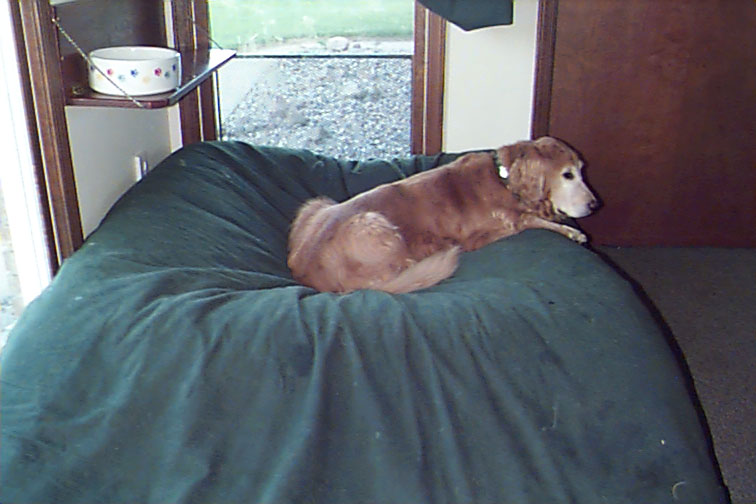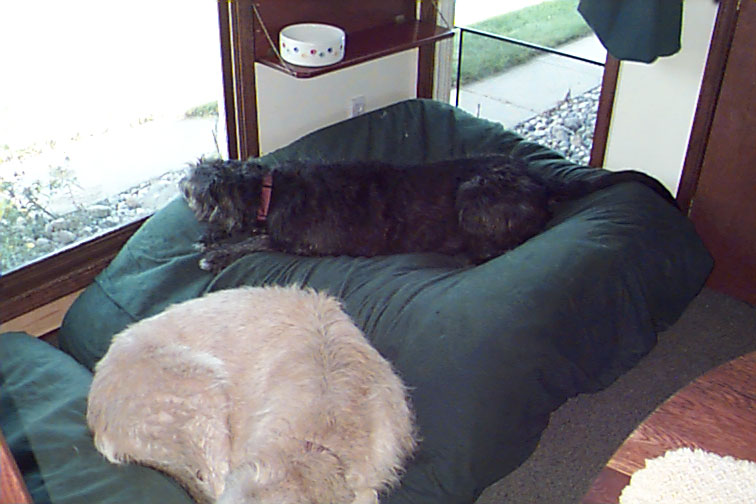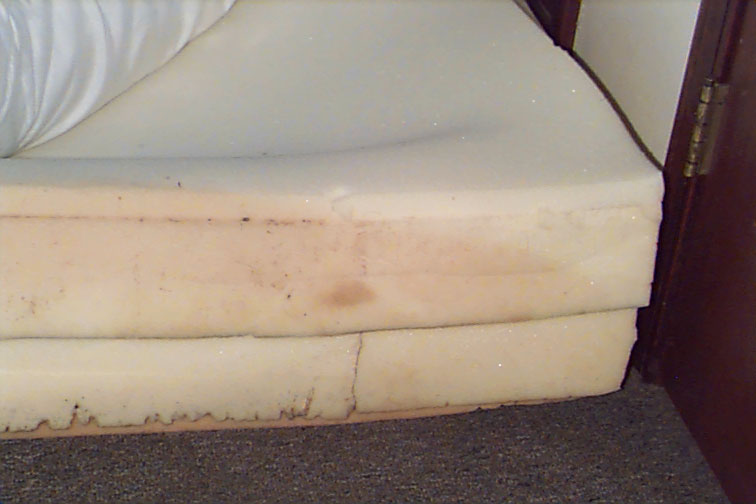Dogs with Special Needs
Megaesophagus:
We have an Irish Wolfhound with
a congenital (from birth) Megaesophagus (very large and not very functional
esophagus). Normally the esophagus functions by pushing the food
down into the stomach. As you can imagine, if the food does not go
down it sometimes comes back up.
Frequently, this is a fatal malformation.
We succeeded through prayer, persistence, and mostly ignorance. She is now (11/2000) almost 7 and runs and jumps and plays like any other wolfhound. Here
is some of what we have discovered:
-
1: ELEVATE the feeding
table, always and for both food and water. As the puppy grows keep
the table higher and higher. We went so far as to have the dog put
her front legs on a raised platform so she could reach the (even higher)
food. Remember: "GRAVITY IS GOOD !"
-
2: ELEVATE the dog's head,
as often as you can. We have a pillow that we put under her head
when she lays down. Now she knows the command, "pillow." Her
bed has rolled up blankets (rolled into waterproof mattress pads !) all
around the edges so no matter which direction she lays her head is higher
than her stomach. "GRAVITY IS GOOD!" We have a tether set up
so that we can tether her there when she (or we !) need a rest. She
sleeps there at night. (see details below)
-
3: Fret not when the food
comes up and the dog eats it again and it comes up and ....... Each time
more will make it into the stomach.
-
4: Feed small meals, frequently.
You will quickly learn how much food your dog can keep down in any 8 hour
period. Fionna can keep down exactly 1.1 cups per 3 hour period -
so, as an adult, we feed her just over 1 cup for breakfast and lunch. Encourage her to drink water before and after meals, but not a lot at one time (else it will reappear). We let her drink frequently, but never more than about 2 cups at a time. This is not a problem unless she has been out running, That is the only time we need to limit her fluids. You will be busy, busy, busy ! Then make sure her head stays up: "GRAVITY IS GOOD!"
-
5: Work with your vet
to find a food with high calorie density. We feed her the Eukanuba Maximum Calorie Diet
(formerly called the Veterinary Recovery Diet). Until recently we were feeding her in the morning and noon and she got 1/2 of a 6 oz can,
1 cup of the kibble, mixed with 2 tablespoon of water and about 6 tablespoons
(3 "squirts") of cooking oil.
We have recently started just feeding her the Eukanuba Maximum Calorie canned, 2 cans in the morning, 2 cans in the late morning, and 2 cans in the early afternoon, mixed with oil and water to make a thin soup. MUCH LESS regurgitation and thus a happier dog and much happier owner.
Eukanuba Veterinary products are
available in North and South America, but only through a vet.
-
6: Buy a portable carpet shampooer.
Actually this is a necessity for anyone with a puppy, but this is especially
true with a dog with megaesophagus. We love the Bissell "Little Green
Clean Machine."
-
7: Arrange with your vet to
have antibiotics on hand so that when the dog starts coughing a lot you
can start antibiotics for the presumed aspiration pneumonia. You
also need a rectal thermometer, but you knew that already - right ?
Put your ear against the dog's chest when the dog is lying quietly and
listen to what a normal dog sounds like when it is breathing. If
you hear crackles and/or it sounds wet, it might be pneumonia. Dogs
with megaesophagus have a much higher chance of getting pneumonia when
they inhale some of the food/water the dog has eaten, but that has not
made it down to the stomach yet.
Dog Beds:
A very important part of keeping the dog healthy is keeping his/her head elevated at all times. We built some special beds for Fionna. There is one in the dining room and one in the bedroom. (when she is with me in my office at home I watch carefully to make sure she always has her head on a (regular, human type bed) pillow. At work she has a bed very much like the bedroom bed.
Note the declivity in the center. Fionna can basically sleep facing any way and have her head up.
(Golden Retriever for color contrast only)
 |
Also very important is having the feeding station elevated. Our feeding station is at the left of the picture above and is just above her shoulder height when she is standing on the edge of the bed.
After the meal, relaxing and letting the food settle (literally). Fionna is in her bed and Tulia likes to lie next to it.
 |
The Bed is consists of a base made of layers of foam rubber glued together with a spray glue. Over it is thrown a double size futon. Over that is a waterproof mattress pad and on top is a queen size waterbed sheet (so the corners are deeper (much credit to Deborah for thinking of that) and can cover up the futon and the base.
There is a layer of 1 inch foam top and bottom that holds it all together and then the sides are made of strips of 4 inch foam (with the bottom one 12 inches wide and the top one 6 inches wide)
 |
In the bedroom is a bed entirely made of foam. It is 26 inches wide and 48 inches long. (Twin sheets fit nicely as it is smaller than a twin bed) Only one end/side is raised and the teether is at that end and not real long. Wolfies generally like to lie with their heads elevated (or better yet: elevated and hanging over the edge - which is fine for this as the most important thing is to keep the top of the esophagus (at the top of the neck) above the lower end of the esophagus/stomach so gravity can do it's work.)
Fionna in bed.The tether is in the center at the head of the bed, but not visible here.
 |
Note the tether. Not real long, but long enough so she can turn over at night or roll over to get her tummy scratched.
 |
The bed is made up of pieces of foam, spray glued.
Again: one inch foam top and bottom to hold it together and two layers of 4 inch foam on the sides at the head and left side.
 |







